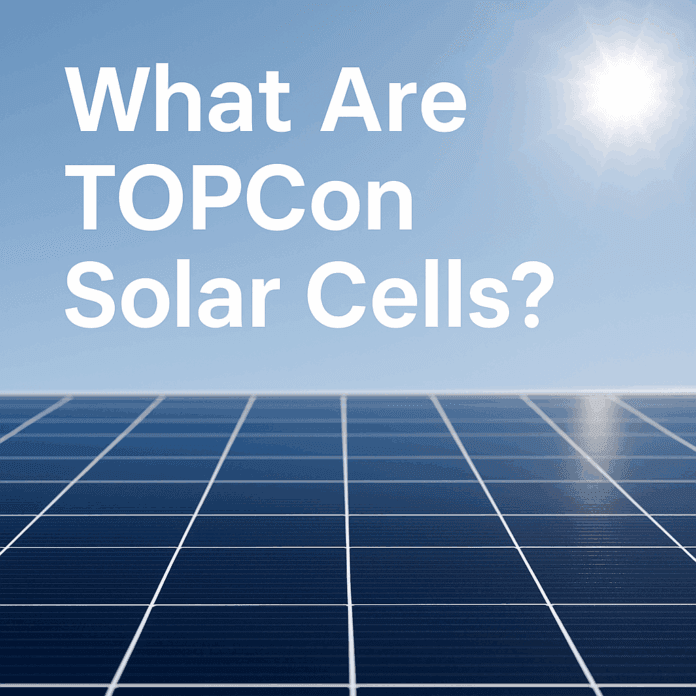🌞 Introduction: What Are TOPCon Solar Cells?
TOPCon Solar Cells—short for Tunnel Oxide Passivated Contact—are the next-generation solar technology pushing the limits of solar panel efficiency and performance. As energy demands grow and the need for higher output from limited space increases, TOPCon cells are becoming a game-changer in both residential and commercial solar projects.
But what exactly are TOPCon cells? How do they differ from traditional solar cells, and why are experts calling them the future of solar?
Let’s explore the answers in detail.
🧬 What Is TOPCon Technology?
TOPCon stands for Tunnel Oxide Passivated Contact, a solar cell structure designed to reduce energy loss and improve efficiency. It is based on n-type crystalline silicon wafers and features:
- A thin tunnel oxide layer
- A passivated contact layer made of doped polycrystalline silicon
- Improved carrier selectivity and reduced recombination losses
This advanced contact design allows electrons to move freely while blocking unwanted charge recombination, which is one of the major causes of energy loss in solar cells.
🔬 Structure of a TOPCon Solar Cell
Here’s a simplified breakdown of how a TOPCon solar cell is structured:
- N-type Silicon Wafer – The base material with higher resistance to light-induced degradation.
- Tunnel Oxide Layer – An ultra-thin insulating layer (~1–2 nm thick) that separates the wafer from the contact layer.
- Poly-Silicon Layer – Doped to enhance electrical conductivity and passivation.
- Passivation Layer – Reduces defects and enhances light absorption.
- Front and Rear Contacts – Collect and transmit the electrical current efficiently.
⚙️ How Do TOPCon Cells Work?
In traditional solar cells, metal contacts directly touch the silicon, which leads to recombination losses—where charge carriers (electrons and holes) cancel each other out before generating electricity.
TOPCon cells fix this by using a tunnel oxide layer that:
- Acts as a barrier to recombination, and
- Allows quantum tunneling of electrons, preserving their energy state.
This design significantly boosts the open-circuit voltage (Voc) and fill factor (FF), leading to higher overall conversion efficiency.
📊 Efficiency Comparison: TOPCon vs Other Technologies
| Technology | Base Type | Typical Efficiency | Remarks |
|---|---|---|---|
| Polycrystalline | P-type | 15–17% | Low cost, low efficiency |
| Monocrystalline | P-type | 18–20% | Standard in most panels |
| PERC | P-type | 20–21.5% | Improved light capture |
| TOPCon | N-type | 22–23.5% | High efficiency, long-term stability |
| HJT (Heterojunction) | N-type | 23–24%+ | Complex, higher production cost |
👉 TOPCon sits in the sweet spot between cost, efficiency, and manufacturability—making it ideal for mass production.
✅ Advantages of TOPCon Solar Cells
1. Higher Efficiency
TOPCon cells can achieve 22%+ efficiency, outperforming traditional mono and PERC panels.
2. Better Low-Light Performance
Thanks to its n-type base, it performs better under low sunlight or cloudy weather.
3. Lower Degradation
TOPCon is more resistant to light-induced degradation (LID) and potential-induced degradation (PID).
4. Longer Lifespan
Stable materials and improved passivation result in longer-lasting panels—ideal for large-scale deployments.
5. Bifacial Potential
Most TOPCon panels are bifacial, meaning they generate power from both front and rear sides.
❌ Disadvantages of TOPCon Cells
Despite their benefits, TOPCon solar cells have a few drawbacks:
- Higher Manufacturing Cost: Due to additional processing steps and materials.
- More Complex Production: Requires precise control over tunneling oxide and doped layers.
- Still Evolving: Not as mature as PERC or mono-crystalline panels in terms of global production scale.
💡 Where Is TOPCon Being Used?
TOPCon technology is quickly gaining traction among leading solar manufacturers and utility-scale solar farms. Major players like LONGi, JinkoSolar, Trina Solar, and JA Solar have launched TOPCon-based panel series.
It is now being used in:
- Rooftop residential systems
- Commercial solar installations
- Utility-scale solar farms
- Solar projects where space is limited but high output is needed
🔮 Future of TOPCon Technology
TOPCon is poised to become the dominant solar cell technology in the next 3–5 years. With:
- Mass production costs decreasing
- Efficiency records improving
- Compatibility with bifacial and flexible solar designs
…TOPCon is seen as the bridge between traditional silicon panels and future technologies like tandem and perovskite cells.
❓ Frequently Asked Questions
🔹 What does TOPCon stand for in solar?
TOPCon stands for Tunnel Oxide Passivated Contact, a solar cell design for high efficiency.
🔹 Are TOPCon Solar Cells based panels better than PERC?
Yes. TOPCon panels generally offer higher efficiency, lower degradation, and better low-light performance than PERC.
🔹 Who manufactures TOPCon solar panels?
Companies like LONGi, JinkoSolar, JA Solar, and Trina Solar are leading in TOPCon module production.
🔹 Is TOPCon the best solar technology?
It’s currently among the best in terms of commercial viability and efficiency, especially when compared to PERC and mono.
📝 Conclusion: Should You Choose TOPCon Solar Panels?
If you’re planning a new solar installation and care about:
- Higher energy output
- Long-term reliability
- Better performance in all weather conditions
…then TOPCon is worth considering. While the upfront cost might be slightly higher than standard panels, the efficiency gains and longer service life could mean better ROI over time.
TOPCon is not just a trend—it’s the next chapter in solar innovation.



